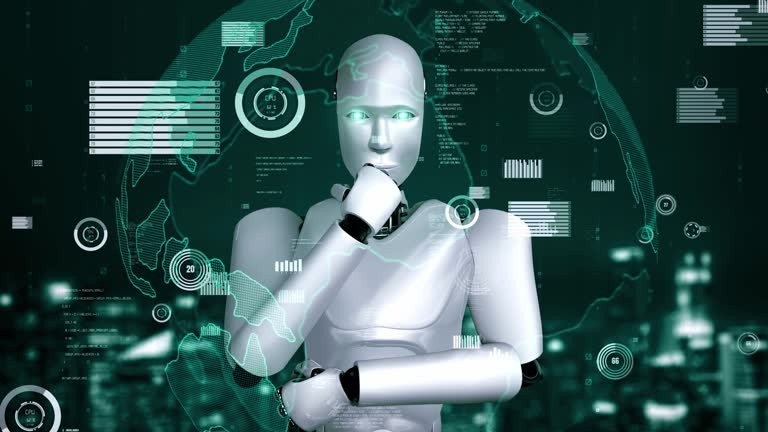The rise of autonomous robots in various sectors—from healthcare and manufacturing to transportation and entertainment—has raised important ethical questions about their role in society. While these robots offer numerous benefits, including increased efficiency, cost savings, and the ability to perform tasks that are dangerous or impossible for humans, their widespread deployment also brings concerns. These ethical concerns span a variety of areas, such as privacy, safety, employment, accountability, and the broader societal implications of human-robot interactions.
In this article, we will explore the ethical implications of autonomous robots, examining both the potential benefits and the challenges they present to individuals, organizations, and society as a whole.
What Are Autonomous Robots?
Autonomous robots are machines capable of performing tasks and making decisions without human intervention. These robots use artificial intelligence (AI), machine learning, and various sensors to process information and interact with their environment. Unlike traditional robots that follow pre-programmed instructions, autonomous robots can adapt their behavior based on new inputs, enabling them to function in dynamic, real-world settings.
Examples of autonomous robots include:
- Self-driving cars: Vehicles that navigate and operate without human drivers.
- Service robots: Robots used in hotels, restaurants, or hospitals to assist with tasks such as delivery, cleaning, or patient monitoring.
- Industrial robots: Machines used in manufacturing that can autonomously assemble parts or carry out inspections.
- Drones: Unmanned aerial vehicles that can perform tasks like surveillance, delivery, and agriculture monitoring.
As these robots become increasingly autonomous, their capacity to make decisions without human oversight leads to important ethical dilemmas.
Ethical Implications of Autonomous Robots
1. Privacy and Surveillance
One of the most pressing ethical concerns surrounding autonomous robots is the potential invasion of privacy. Many autonomous robots, particularly drones and service robots, rely on cameras, sensors, and data collection tools to perform their tasks. This means that they could gather vast amounts of sensitive personal information, often without explicit consent.
- Surveillance: Autonomous robots, especially those in public spaces, could be used for surveillance purposes, raising concerns about the erosion of personal privacy. For example, self-driving cars equipped with cameras and sensors might inadvertently capture and store information about individuals’ movements and behaviors. The possibility of widespread surveillance could infringe on individuals’ right to privacy, leading to a society where people feel constantly watched.
- Data Security: The data collected by autonomous robots could be vulnerable to cyberattacks, misuse, or unauthorized access. If sensitive personal data, such as health information or financial details, is stored or transmitted by robots, there is a significant risk of data breaches. Ensuring strong security measures and regulations around data collection is essential to mitigate these risks.
2. Job Displacement and Economic Inequality
As autonomous robots become more capable, they are increasingly being used to replace human labor in a variety of industries, from manufacturing to transportation. While this shift offers productivity gains, it also raises concerns about job displacement and economic inequality.
- Job Loss: One of the most immediate ethical challenges is the potential for widespread unemployment as robots replace human workers. For example, self-driving trucks could put millions of truck drivers out of work, while robots in warehouses and factories may replace manual laborers. This displacement could disproportionately affect lower-skilled workers, leading to significant job losses in certain sectors.
- Economic Inequality: The widespread adoption of autonomous robots could exacerbate existing economic inequalities. Those who own or control the robots—often large corporations—could see increased profits, while workers who lose their jobs may struggle to find new employment opportunities. If society does not implement policies to retrain workers and redistribute the benefits of automation, it could lead to greater wealth inequality and social unrest.
3. Accountability and Responsibility
The question of who is responsible when autonomous robots make mistakes or cause harm is a complex ethical issue. As robots become more autonomous and make decisions based on AI algorithms, determining accountability in cases of accidents or unethical behavior becomes increasingly difficult.
- Liability for Accidents: If an autonomous car causes an accident, who is responsible—the manufacturer, the software developer, the owner of the vehicle, or the robot itself? Current legal frameworks often do not have clear answers, leaving gaps in accountability. In the case of robots in healthcare, if an autonomous robot makes an error in diagnosis or treatment, determining who should be held accountable becomes even more difficult.
- AI Decision-making: Autonomous robots often rely on AI to make decisions. However, AI is not infallible, and algorithms can make errors or operate in unintended ways. If a robot causes harm or makes biased decisions, there is an ethical dilemma about how to hold AI systems accountable. For instance, if a robot is programmed to make a decision based on data that reflects biased human judgments, the robot could perpetuate discrimination and harm vulnerable populations.
4. Safety and Security
The deployment of autonomous robots in everyday life also raises concerns about safety. As robots become more capable of performing complex tasks, ensuring they operate safely around humans and other machines is paramount.
- Malfunction and Safety Hazards: Autonomous robots, like self-driving cars, could malfunction and cause accidents. For example, a robot might misinterpret sensor data or fail to recognize hazards, leading to collisions or injuries. The safety of these robots is a key concern, and manufacturers must ensure that their designs undergo rigorous testing to prevent accidents.
- Hacking and Cybersecurity: Autonomous robots are highly reliant on software and connectivity, making them vulnerable to hacking and cyberattacks. A hacker could take control of a robot, turning it into a weapon or causing it to malfunction in harmful ways. As robots become more integrated into critical infrastructure, such as hospitals or transportation systems, ensuring their cybersecurity becomes even more crucial.
5. Moral and Ethical Decision-making
Autonomous robots, especially those used in high-risk environments like healthcare, warfare, and autonomous vehicles, may be required to make moral or ethical decisions. This raises questions about how robots should be programmed to act in morally ambiguous situations.
- Moral Dilemmas: Self-driving cars, for example, may face situations where they must choose between two harmful outcomes, such as deciding whether to harm the passenger or avoid pedestrians in an unavoidable accident. Should the robot prioritize the safety of the passenger, the pedestrian, or the greater number of people? These types of moral decisions—often referred to as the “trolley problem” in philosophy—pose significant ethical dilemmas for developers and society at large.
- Bias and Discrimination: Robots may inherit biases from the data they are trained on. For example, if AI systems are trained on data that reflects societal biases, robots may make biased decisions that disproportionately affect certain groups. This can lead to ethical issues regarding fairness and equality, especially when robots are used in decision-making processes that impact people’s lives, such as hiring or criminal justice.
6. Human-Robot Relationships and Social Impact
As robots become more autonomous, they will increasingly interact with humans in personal, professional, and social contexts. These interactions could affect the way people perceive and relate to robots.
- Dehumanization: One ethical concern is the potential for people to dehumanize themselves by relying too heavily on robots. For example, the use of robots in caregiving roles or as companions could lead to emotional detachment from human relationships. There is a risk that individuals may prefer interactions with robots over real human connections, leading to social isolation and a diminished sense of community.
- Human Dignity: In certain contexts, such as caregiving or personal assistance, robots could undermine human dignity. For instance, if elderly individuals or those with disabilities become overly reliant on robots for basic tasks, it may compromise their sense of independence and self-worth. Balancing the benefits of autonomy with the need to preserve human dignity is a key ethical challenge.
Conclusion
The rise of autonomous robots presents both significant opportunities and ethical challenges that society must address. On the one hand, robots can increase efficiency, improve safety, and enhance the quality of life in many areas, from healthcare to transportation. On the other hand, issues related to privacy, job displacement, accountability, safety, and moral decision-making pose complex ethical dilemmas that require careful consideration.
As autonomous robots become increasingly integrated into society, it will be essential for policymakers, technologists, and ethicists to work together to create frameworks that ensure these technologies are developed and deployed responsibly. This includes creating robust legal frameworks, addressing job displacement through education and retraining, ensuring that AI systems are transparent and accountable, and safeguarding human rights and dignity. In navigating these ethical challenges, society can harness the potential of autonomous robots while mitigating their risks and ensuring that they contribute positively to the well-being of all.


lightroom crack
adobe photoshop crack
acrobat crack
adobe acrobat crack
premiere pro crack
adobe premiere pro crack
filmora crack
filmora crack 2025
Lightroom crack
adobe Lightroom free download
disk drill crack
JetBrains crack
JetBrains PyCharm crack